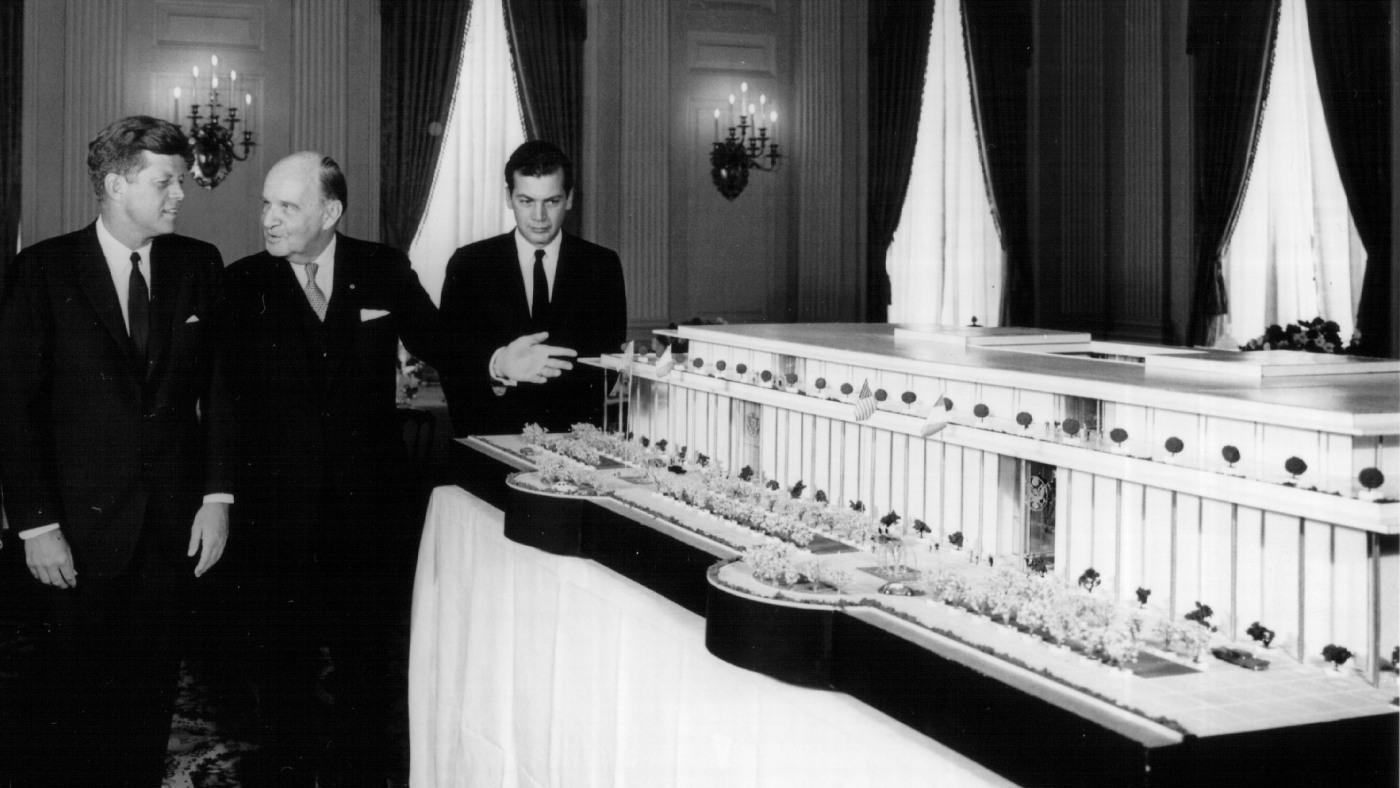Lifestyle
'Demure' is Dictionary.com's word of the year. If that's news to you, here's the backstory

Dictionary.com lexicographers analyze headlines, social media trends, search engine results and other data to come up with the word of the year. This year, it’s “demure.”
Dictionary.com/Screenshot by NPR
hide caption
toggle caption
Dictionary.com/Screenshot by NPR
“Demure” is Dictionary.com’s word of the year, with all the credit for its popularity going to lifestyle and beauty influencer Jools Lebron and her catchphrase, “very demure, very mindful.”
“Demure” means “reserved, quiet, or modest,” but the reaction to Lebron’s use of the word was anything but.
Dictionary.com calls demure’s rise in usage “meteoric” in 2024, after Lebron started using it in early August.

“Between August 2023 and July 2024, there was no significant trend in the usage of the word demure,” according to Dictionary.com. “By the week of Aug. 18, 2024, however, there was almost 14 times more interest in the term, highlighting the term’s almost overnight explosion in popularity. At the peak of the trend, demure had 200 times more searches on Dictionary.com than it did on dates preceding August.”
Dictionary.com’s lexicographers analyze headlines, social media trends, search engine results and other data to come up with its word of the year, calling it a “linguistic time capsule” that captures “pivotal moments in language and culture.”
The moment was certainly pivotal for Lebron. Her TikTok audience skyrocketed. Celebrities, including Jennifer Lopez and Khloé Kardashian, made their own “demure” videos. Lebron was interviewed on CBS Mornings and appeared on Jimmy Kimmel Live! with guest host RuPaul.
“Very demure, very mindful” was so popular, there was a surge in trademark applications by people trying to capitalize on Lebron’s motto.
Lebron reacted demurely to the news.
Other words that stood out for Dictionary.com’s lexicographers this year were “brainrot,” “brat” and “extreme weather.”

Lifestyle
Bowen Yang leaves ‘SNL’ midway through his 8th season

Bowen Yang is leaving Saturday Night Live midway through his 8th season with the long-running, late-night comedy sketch series.
Jamie McCarthy/Getty Images
hide caption
toggle caption
Jamie McCarthy/Getty Images
Comedian Bowen Yang is leaving Saturday Night Live midway through the season, his eighth with the long-running NBC late-night sketch comedy series. The performer is scheduled to participate in his final show Saturday, which will be hosted by Wicked star Ariana Grande. Cher is the musical guest.
Yang has not publicly shared the reason for his abrupt departure from SNL. In a social media post on Saturday, the comedian thanked the team and expressed gratitude for “every minute” of his time with the show.
“I loved working at SNL, and most of all I loved the people,” Yang wrote. “I was there at a time when many things in the world started to seem futile, but working at 30 Rock taught me the value in showing up anyway when people make it worthwhile.”

Yang, 35, was one of SNL‘s most prominent recent cast members.
His most famous work on the show includes “The Iceberg That Sank the Titanic,” a “Weekend Update” segment where Yang personifies the infamous iceberg; a commercial spoof co-starring Travis Kelce — “Straight Male Friend” — advertising the benefits of low-stakes friendships; and his recurring impression of expelled congressman George Santos. At one point, Yang also performed a sketch in which he played an intern on NPR’s Tiny Desk concert series.
Yang has been nominated for five Emmy Awards for his work on the series. Beyond SNL, the performer’s credits include the 2022 romantic comedy Fire Island, the musical Wicked (2024) as well as its sequel, Wicked: For Good (2025), and the remake of The Wedding Banquet (2025). He also co-hosts the Las Culturistas podcast with actor and comedian Matt Rogers.
Yang, the show’s first Chinese American cast member, rose through SNL‘s ranks after joining the show as a staff writer in 2018. A year later, he was promoted to on-air talent and eventually became a series regular.
Yang talked about the natural turnover at SNL and hinted at life beyond the show in an interview with People earlier this year. “It’s this growing, living thing where new people come in and you do have to sort of make way for them and to grow and to keep elevating themselves,” he said. “And that inevitably requires me to sort of hang it up at some point — but I don’t know what the vision is yet.”
He joins other cast members who have recently left the show. Heidi Gardner, Ego Nwodim and Devon Walker are among those who departed ahead of the 51st season, which launched in October.
Yang’s reps did not immediately respond to NPR’s request for comment. The series’ network, NBCUniversal, referenced Yang’s social media post, but provided no further comment.
Though uncommon, there have been a few other mid-season SNL departures in the past, including Cecily Strong, Dana Carvey and Eddie Murphy.
Fellow entertainers have commented on Yang’s departure on social media. “Iconic. (Understatement)” wrote actor Evan Ross Katz on Instagram in response to Yang’s post. “Congrats!” wrote comedian Amber Ruffin. “Please make more The Wedding Banquets.”
NPR critic-at-large Eric Deggans called Yang’s departure, even if inevitable, a setback for the show.
“SNL thrives when it has a large crop of utility players who can pull comedic gold from the dodgiest sketch ideas,” Deggans said, counting Yang among the most talented in recent seasons of the show’s cast to fill that role.
“No matter what he was asked to do, from playing the iceberg that sunk the Titanic to playing North Korean leader Kim Jong-un, he was able to wring maximum laughs and patch up SNL’s historic lack of representation regarding Asian performers,” he added.
But Yang, Deggans noted, may have reached an apex of what he could achieve on the show, “and it might be time for him to leave, while his star is still ascending and there are opportunities beyond the program available to him which might not be around for long.”
Lifestyle
Tekashi 6ix9ine Home Invasion Suspect Arrested

Tekashi 6ix9ine
Home Invasion Suspect Arrested
Published
A suspect has been arrested in connection to the scary invasion of Tekashi 6ix9ine‘s home … TMZ has learned.
Pedro Roriguez — a 19-year-old man — was arrested and charged with armed home invasion robbery with a firearm, false imprisonment, grand theft and posession of marijuana with intent to sell or deliver … according to the Palm Beach County Sheriff’s Office.
Authorities say Rodriguez is just one of several suspects … and, the investigation remains ongoing.
We broke the story … four gunmen ransacked the rapper’s Florida crib last month with video capturing the invaders slipping in through the garage and holding Tekashi’s mom against her will.
The clip shows one person standing guard over Tekashi’s mom, who can be heard on the video begging and pleading with the men … while the crew tear through the house looking for valuables.
We spoke to cops at the time … and, they told us the men wanted cash and car keys. They sped off in a getaway car before authorities arrived.
Lifestyle
It was called the Kennedy Center, but 3 different presidents shaped it

President John F. Kennedy, left, looks at a model of what was later named the Kennedy Center in Washington, DC., in 1963.
National Archives/Getty Images
hide caption
toggle caption
National Archives/Getty Images
On Thursday, the Kennedy Center’s name was changed to The Donald J. Trump and the John F. Kennedy Memorial Center for the Performing Arts.

By Friday morning, workers were already changing signs on the building itself, although some lawmakers said Thursday that the name can’t be changed legally without Congressional approval.
Though the arts venue is now closely associated with President Kennedy, it was three American presidents, including Kennedy, who envisioned a national cultural center – and what it would mean to the United States.

New signage, The Donald J. Trump and The John F. Kennedy Memorial Center for the Performing Arts, is unveiled on Friday in Washington, D.C.
Jacquelyn Martin/AP
hide caption
toggle caption
Jacquelyn Martin/AP
The Eisenhower Administration
In 1955, President Dwight D. Eisenhower first pursued building what he called an “artistic mecca” in Washington, D.C., and created a commission to create what was then known as the National Cultural Center.
Three years later, Congress passed an act to build the new venue with the stated purpose of presenting classical and contemporary music, opera, drama, dance, and poetry from the United States and across the world. Congress also mandated the center to offer public programs, including educational offerings and programs specifically for children and older adults.
The Kennedy Administration
A November 1962 fundraiser for the center during the Kennedy administration featured stars including conductor Leonard Bernstein, comedian Danny Kaye, poet Robert Frost, singers Marian Anderson and Harry Belafonte, ballerina Maria Tallchief, pianist Van Cliburn – and a 7-year-old cellist named Yo-Yo Ma and his sister, 11-year-old pianist Yeou-Cheng Ma.

In his introduction to their performance, Bernstein specifically celebrated the siblings as new immigrants to the United States, whom he hailed as the latest in a long stream of “foreign artists and scientists and thinkers who have come not only to visit us, but often to join us as Americans, to become citizens of what to some has historically been the land of opportunity and to others, the land of freedom.”
At that event, Kennedy said this:
“As a great democratic society, we have a special responsibility to the arts — for art is the great democrat, calling forth creative genius from every sector of society, disregarding race or religion or wealth or color. The mere accumulation of wealth and power is available to the dictator and the democrat alike; what freedom alone can bring is the liberation of the human mind and spirit which finds its greatest flowering in the free society.”
YouTube
Kennedy and his wife Jacqueline were known for championing the arts at the White House. The president understood the free expression of creativity as an essential soft power, especially during the Cold War, as part of a larger race to excellence that encompassed science, technology, and education – particularly in opposition to what was then the Soviet Union.
The arts mecca envisioned by Eisenhower opened in 1971 and was named as a “living memorial” to Kennedy by Congress after his assassination.
The Johnson Administration
Philip Kennicott, the Pulitzer Prize-winning art and architecture critic for The Washington Post, said the ideas behind the Kennedy Center found their fullest expression under Kennedy’s successor, President Lyndon B. Johnson.

“Johnson in the Great Society basically compares the arts to other fundamental needs,” Kennicott said. “He says something like, ‘It shouldn’t be the case that Americans live so far from the hospital. They can’t get the health care they need. And it should be the same way for the arts.’ Kennedy creates the intellectual fervor and idea of the arts as essential to American culture. Johnson then makes it much more about a kind of popular access and participation at all levels.”
Ever since, Kennicott said, the space has existed in a certain tension between being a palace of the arts and a publicly accessible, popular venue. It is a grand structure on the banks of the Potomac River, located at a distance from the city’s center, and decked out in red and gold inside.
At the same time, Kennicott observed: “It’s also open. You can go there without a ticket. You can wander in and hear a free concert. And they have always worked very hard at the Kennedy Center to be sure that there’s a reason for people to think of it as belonging to them collectively, even if they’re not an operagoer or a symphony ticket subscriber.”

The Kennedy Center on the Potomac River in Washington, D.C.
Hulton Archive/Getty Images
hide caption
toggle caption
Hulton Archive/Getty Images
Kennicott estimated it will only take a few years for the controversies around a new name to fade away, if the Trump Kennedy moniker remains.
He likens it to the controversy that once surrounded another public space in Washington, D.C.: the renaming of Washington National Airport to Ronald Reagan Washington National Airport in 1998.

“A lot of people said, ‘I will never call it the Reagan National Airport.’ And there are still people who will only call it National Airport. But pretty much now, decades later, it is Reagan Airport,” Kennicott said.
“People don’t remember the argument. They don’t remember the controversy. They don’t remember the things they didn’t like about Reagan, necessarily. . . . All it takes is about a half a generation for a name to become part of our unthinking, unconscious vocabulary of place.
“And then,” he said, “the work is done.”
This story was edited for broadcast and digital by Jennifer Vanasco. The audio was mixed by Marc Rivers.
-

 Iowa6 days ago
Iowa6 days agoAddy Brown motivated to step up in Audi Crooks’ absence vs. UNI
-

 Iowa1 week ago
Iowa1 week agoHow much snow did Iowa get? See Iowa’s latest snowfall totals
-

 Maine4 days ago
Maine4 days agoElementary-aged student killed in school bus crash in southern Maine
-

 Maryland6 days ago
Maryland6 days agoFrigid temperatures to start the week in Maryland
-

 Technology1 week ago
Technology1 week agoThe Game Awards are losing their luster
-

 South Dakota7 days ago
South Dakota7 days agoNature: Snow in South Dakota
-

 New Mexico4 days ago
New Mexico4 days agoFamily clarifies why they believe missing New Mexico man is dead
-

 World1 week ago
World1 week agoCoalition of the Willing calls for transatlantic unity for Ukraine



















